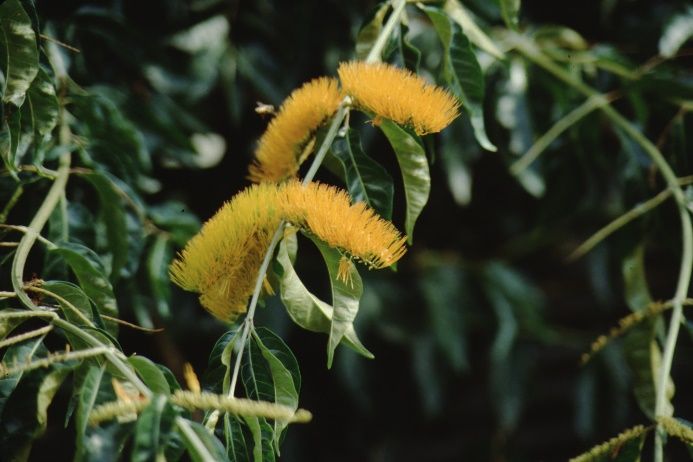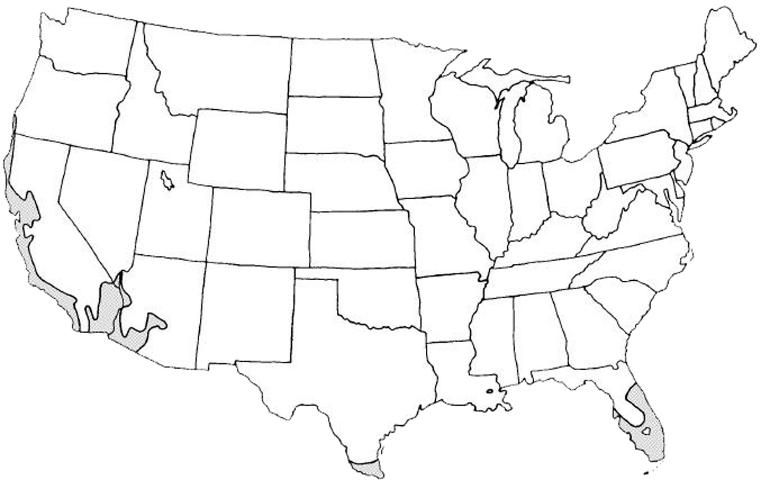Introduction
Delicate orange flowers borne in the axil of the opposite; simple leaves put on a spectacular show in the early part of the warm summer months. The flowering period can be extended into the fall in some years. Good growing conditions in partial to full sun results in dense foliage growth with flowers borne on the tips of new growth. Shoots can extend several feet from the fence or other structure supporting the vine. Plan on this when locating the vine since regular clipping will remove the flowers.

Credit: Edward F. Gilman, UF/IFAS

Credit: Edward F. Gilman, UF/IFAS
General Information
Scientific name: Combretum fruticosum
Pronunciation: kom-BREE-tum froo-tick-KOE-sum
Common name(s): orange flame vine
Family: Combretaceae
Plant type: vine
USDA hardiness zones: 9B through 11 (Figure 3)
Planting month for zone 9: year round
Planting month for zone 10 and 11: year round
Origin: not native to North America
Invasive potential: not known to be invasive
Uses: trained as a standard; espalier
Availability: grown in small quantities by a small number of nurseries

Credit:
Description
Height: depends upon supporting structure
Spread: 10 to 20 feet
Plant habit: spreading; round
Plant density: moderate
Growth rate: fast
Texture: medium
Foliage
Leaf arrangement: opposite/subopposite
Leaf type: simple
Leaf margin: entire
Leaf shape: elliptic (oval)
Leaf venation: pinnate
Leaf type and persistence: evergreen
Leaf blade length: 4 to 8 inches
Leaf color: green
Fall color: no fall color change
Fall characteristic: not showy
Flower
Flower color: orange
Flower characteristic: summer flowering; fall flowering
Fruit
Fruit shape: unknown
Fruit shape: unknown
Fruit shape: unknown
Fruit shape: unknown
Fruit characteristic: inconspicuous and not showy
Trunk and Branches
Trunk/bark/branches: not particularly showy; typically multi-trunked or clumping stems
Current year stem/twig color: reddish
Current year stem/twig thickness: thin
Culture
Light requirement: plant grows in full sun
Soil tolerances: acidic; slightly alkaline; sand; loam; clay
Drought tolerance: moderate
Soil salt tolerances: poor
Plant spacing: 36 to 60 inches
Other
Roots: usually not a problem
Winter interest: no special winter interest
Outstanding plant: plant has outstanding ornamental features and could be planted more
Pest resistance: long-term health usually not affected by pests
Use and Management
Orange flame vine can also be grown as a loose shrub, becoming at least 10 to 15 feet wide and 6 to 8 feet tall. It can be planted 5 to 8 feet apart to form a solid mass within a couple of years after planting. It makes a good soil stabilizer for steep slopes.
Supply the plant with regular irrigation during dry weather to maintain good growth and flowering. Periodic fertilization during the year also helps keep the plant in flower. Other species exist including Combretum grandiflorum which has red flowers and reddish new growth.
Pests and Diseases
No major insect or disease problems are known to affect the plant at this time.